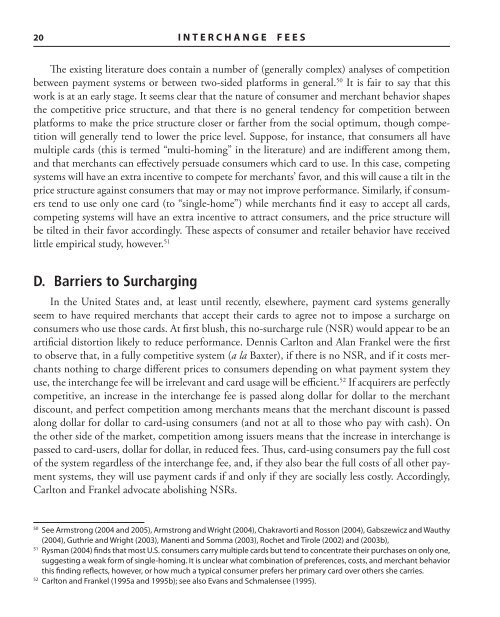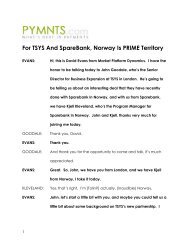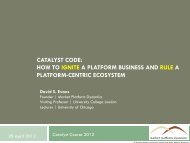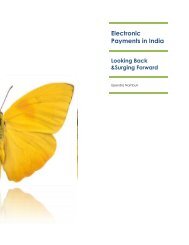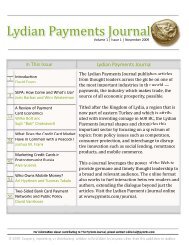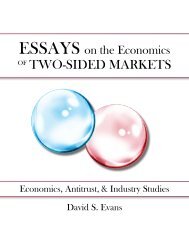Interchange Fees: The Economics and Regulations of What
Interchange Fees: The Economics and Regulations of What
Interchange Fees: The Economics and Regulations of What
- No tags were found...
Create successful ePaper yourself
Turn your PDF publications into a flip-book with our unique Google optimized e-Paper software.
20 INTERCHANGE FEES<strong>The</strong> existing literature does contain a number <strong>of</strong> (generally complex) analyses <strong>of</strong> competitionbetween payment systems or between two-sided platforms in general. 50 It is fair to say that thiswork is at an early stage. It seems clear that the nature <strong>of</strong> consumer <strong>and</strong> merchant behavior shapesthe competitive price structure, <strong>and</strong> that there is no general tendency for competition betweenplatforms to make the price structure closer or farther from the social optimum, though competitionwill generally tend to lower the price level. Suppose, for instance, that consumers all havemultiple cards (this is termed “multi-homing” in the literature) <strong>and</strong> are indifferent among them,<strong>and</strong> that merchants can effectively persuade consumers which card to use. In this case, competingsystems will have an extra incentive to compete for merchants’ favor, <strong>and</strong> this will cause a tilt in theprice structure against consumers that may or may not improve performance. Similarly, if consumerstend to use only one card (to “single-home”) while merchants find it easy to accept all cards,competing systems will have an extra incentive to attract consumers, <strong>and</strong> the price structure willbe tilted in their favor accordingly. <strong>The</strong>se aspects <strong>of</strong> consumer <strong>and</strong> retailer behavior have receivedlittle empirical study, however. 51D. Barriers to SurchargingIn the United States <strong>and</strong>, at least until recently, elsewhere, payment card systems generallyseem to have required merchants that accept their cards to agree not to impose a surcharge onconsumers who use those cards. At first blush, this no-surcharge rule (NSR) would appear to be anartificial distortion likely to reduce performance. Dennis Carlton <strong>and</strong> Alan Frankel were the firstto observe that, in a fully competitive system (a la Baxter), if there is no NSR, <strong>and</strong> if it costs merchantsnothing to charge different prices to consumers depending on what payment system theyuse, the interchange fee will be irrelevant <strong>and</strong> card usage will be efficient. 52 If acquirers are perfectlycompetitive, an increase in the interchange fee is passed along dollar for dollar to the merchantdiscount, <strong>and</strong> perfect competition among merchants means that the merchant discount is passedalong dollar for dollar to card-using consumers (<strong>and</strong> not at all to those who pay with cash). Onthe other side <strong>of</strong> the market, competition among issuers means that the increase in interchange ispassed to card-users, dollar for dollar, in reduced fees. Thus, card-using consumers pay the full cost<strong>of</strong> the system regardless <strong>of</strong> the interchange fee, <strong>and</strong>, if they also bear the full costs <strong>of</strong> all other paymentsystems, they will use payment cards if <strong>and</strong> only if they are socially less costly. Accordingly,Carlton <strong>and</strong> Frankel advocate abolishing NSRs.50See Armstrong (2004 <strong>and</strong> 2005), Armstrong <strong>and</strong> Wright (2004), Chakravorti <strong>and</strong> Rosson (2004), Gabszewicz <strong>and</strong> Wauthy(2004), Guthrie <strong>and</strong> Wright (2003), Manenti <strong>and</strong> Somma (2003), Rochet <strong>and</strong> Tirole (2002) <strong>and</strong> (2003b),51Rysman (2004) finds that most U.S. consumers carry multiple cards but tend to concentrate their purchases on only one,suggesting a weak form <strong>of</strong> single-homing. It is unclear what combination <strong>of</strong> preferences, costs, <strong>and</strong> merchant behaviorthis finding reflects, however, or how much a typical consumer prefers her primary card over others she carries.52Carlton <strong>and</strong> Frankel (1995a <strong>and</strong> 1995b); see also Evans <strong>and</strong> Schmalensee (1995).


